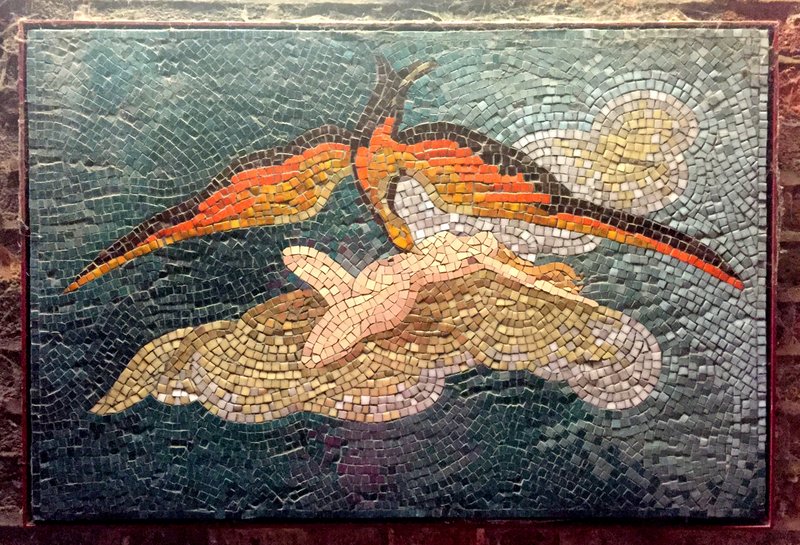Speaking of art, unusual things, and out-of-the-way places, I found all three at once when tooling around on a bike and my route took me through Carlisle Lane behind Waterloo Station. A dark and musty cavern even in broad daylight, I nearly missed the 20 mosaic panels along the length of the tunnel, which I first took to be references to the Bible with all the depictions of angels, demons, and other suffering souls. That’s almost right; Carlisle Lane is one of three streets in the “Blake’s Lambeth” project from Southbank Mosaics, a non-profit and social enterprise devoted to public art and community service through the ancient art of mosaic.

A different kind of street art

It was a pleasant Sunday afternoon bike ride, en route to Southbank Centre… and Citymapper took me straight into a gloomy tunnel around the backside of Waterloo. I hesitated, sure that my iPhone was conspiring yet again to nudge me down a blind alley, to be engulfed by wild graffiti and all manner of odd shadowy corners.
But then I realised, instead of paint and glittering from beneath all the cobwebs, the “vandals” on Carlisle Lane have decorated this mouldy underpass with 20 or so mosaics, which I first took to be a local church-sponsored project, with references to biblical Jerusalem the jewel of all cities,
a host of devilishly fabulous characters gleefully prancing about,

sinners in a lake of fire where the only options seemed to be swan-dive or cannon-ball…
angelic beauties enlisted for womanly errands,

and other lovely ladies: nurses, mothers, and those who teach children to fly,
then get dive-bombed by a giant bird…

There’s also a sad fish man in it up to his beard,

a peacock troll in the throes of despair,

Wait…what?
Thankfully, like any decent art display, there was a plaque at the end of the tunnel to introduce “Blake’s Lambeth” a community project from a group called Southbank Mosaics, inspired by the life and works of poet-artist-printmaker William Blake (b. 1757, d. 1827). According to the plaque, Blake lived nearby on Hercules Street for a time, hence the connection; besides Carlisle Lane, there are two other such displays in this same area, Virgil Street and Centaur Street, making 70 mosaic works in all.

So back down the tunnel again I went, to really look at these charming and quirky cobbles, this time to be reminded that gems of creative passion can hide anywhere, and all I have to do is pay attention…
About Southbank Mosaics
For Southbank Mosaics, this historic art form is about community, sharing, and learning as much as it is about the simple pleasure of fine craftsmanship. This non-profit organisation based in St John’s Crypt (Waterloo) provides education and volunteering opportunities for artists, researchers, and hobbyists, as well as at-risk youth and other local community groups.

Founded in 2004 by David Tootill, Southbank Mosaics has worked with individuals, organisations, and community projects to develop more than 300 installations all around London, including the regeneration at St. John’s Garden, Blake’s Lambeth (2008-2013) and Queenhithe Timeline Mosaic (2014). A number of smaller commissions include signage for Network Rail at Waterloo Station, paving at Southbank Centre, sculptures, memorials, and private clients.
Southbank Mosaics is a not-for-profit social enterprise, with emphasis on socially-engaged projects, namely focused on:
- “an inclusive economy to provide training and work opportunities for young people/adults with additional needs and mental health problems”
- “working with young people in trouble with the law, as an alternative to custody and allowing them to pay back in a positive way through making public art”

Current programmes include working with school-age children with special needs; “Art on prescription”, referred by GPs for people affected by mental health issues; and work with Lambeth Council in offering opportunities for young people on community service orders, so they may
broaden their sense of opportunity while learning to work in a professional environment and to channel their energy in creative ways
More info about Southbank Mosaics and the William Blake project
- Read about Southbank Mosaics – “a not for profit social enterprise with emphasis on… an inclusive economy, providing training and work opportunities for young people/adults…” and for criminals/would-be offenders, “… providing an alternative to custody, to pay back in a positive way through making public art”
The artists/artisans who contributed to ‘Blake’s Lambeth’:
Adolfo Formoso, Alejandra C Herarra, Ann Cattrall, Anna Cadyworld, Anne Lillquist, Bryony Mottom, Catrina Fryer, Chime Tsewang, Christine Burford, Daquanne Allen, David Stokes, Dee Smith, Devra Brown, Gloria Reyes, Greg Edwards, Holly Spice, Jac West, Matei Ionescu, Victor Spencer, Jay Gray, Jo Thorpe, Joe Pinnock, Jon North, Joshua Gordon, Karen Rizk, Kenneth Tao, Laura Symes, Lewis Drayton-Corbin, Louise Keyne, Luciana Sydow, Marcia Robinson, Maria Palmieri, Mark Ravenscroft, Mary Theocharis, Mollie Fogarty, My Lee Ngu, Luke Bryant, Naomi Hope, Olalade Ladipo, Paula Ligo, Peter O’Donovan, Rashid Ajani, Rosalind B Meadows, Rosanna Thompson, Sherry Shah, Shomari Burford, Sonia Gomes, Sylvia Rajazczuk, Thomas Wallace, Toni Thomas, Tulsi Parikh, Tyrell Stone, Vanessa Morgan, Veronica Marshall, Westley Abbott














Thanks for your lovely comment! They were a joy to discover in such an unlikely place. I look forward to hearing what you the think of them when you see them in person. 🙂 Kelise
I searched for this after seeing it on a TV programme, this is a lovely little tribute to the plaques, well done! I will search them out next time I am in London. 😌